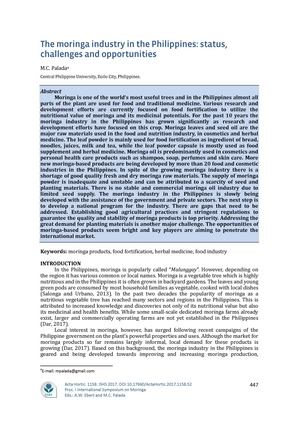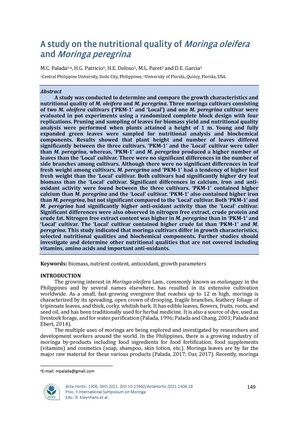The moringa industry in the Philippines: Status, challenges and opportunities

Request
Request a full text copyPage views
7,904Date
2017-05-09Author
Share
Metadata
Show full item record
Abstract
Moringa is one of the world's most useful trees and in the Philippines almost all parts of the plant are used for food and traditional medicine. Various research and development efforts are currently focused on food fortification to utilize the nutritional value of moringa and its medicinal potentials. For the past 10 years the moringa industry in the Philippines has grown significantly as research and development efforts have focused on this crop. Moringa leaves and seed oil are the major raw materials used in the food and nutrition industry, in cosmetics and herbal medicine. The leaf powder is mainly used for food fortification as ingredient of bread, noodles, juices, milk and tea, while the leaf powder capsule is mostly used as food supplement and herbal medicine. Moringa oil is predominantly used in cosmetics and personal health care products such as shampoo, soap, perfumes and skin care. More new moringa-based products are being developed by more than 20 food and cosmetic industries in the Philippines. In spite of the growing moringa industry there is a shortage of good quality fresh and dry moringa raw materials. The supply of moringa powder is inadequate and unstable and can be attributed to a scarcity of seed and planting materials. There is no stable and commercial moringa oil industry due to limited seed supply. The moringa industry in the Philippines is slowly being developed with the assistance of the government and private sectors. The next step is to develop a national program for the industry. There are gaps that need to be addressed. Establishing good agricultural practices and stringent regulations to guarantee the quality and stability of moringa products is top priority. Addressing the great demand for planting materials is another major challenge. The opportunities of moringa-based products seem bright and key players are aiming to penetrate the international market.
Description
Conference paper
Suggested Citation
Palada, M. C. (2017). The moringa industry in the Philippines: Status, challenges and opportunities. In Ebert, A. W. and Palada, M.C. (Eds.), I International Symposium on Moringa (pp. 447-453). International Society for Horticultural Science. https://doi.org/10.17660/ActaHortic.2017.1158.52
Type
Conference paperISSN
0567-7572; 2406-6168ISBN
978-94-62611-55-9Subject(s)
Keywords
Series
ISHS Acta Horticulturae;1158Collections
Related items
Showing items related by title, author, creator and subject.
-
A study on the nutritional quality of Moringa oleifera and Moringa peregrina
Palada, Manuel C.; Patricio, Hope G.; Deloso, Homer E.; Paret, Mathews; Garcia, D. E. (International Society for Horticultural Science, 2021-04-15)A study was conducted to determine and compare the growth characteristics and nutritional quality of <em>M. oleifera</em> and <em>M. peregrina</em>. Three moringa cultivars consisting of two <em>M. oleifera</em> cultivars ... -
Evaluation of the efficacy of essential oil from moringa leaves (Moringa oleifera) against Staphylococcus epidermidis
Mañosa, Rhegil Joseph B. (2024-04)Staphylococcus epidermidis is a coagulase-negative and gram-positive bacterium that can cause arthritis, tendinitis, tenosynovitis, osteomyelitis and omphalitis in poultry animals. It is the most common cause of nosocomial ... -
Brooding performance of Philippine native chicken supplemented with moringa (Moringa oleifera Lam.) and hot red pepper (Capsicum annum L.) as mineral and vitamin premix
Servidad, Layka A. (2019-04)The study was conducted from February 21 to March 14, 2018 at CPU-CARES Research and Development Learning Center, Jaro, Iloilo City. The study was conducted to determine the brooding performance of Philippine native chicken ...





